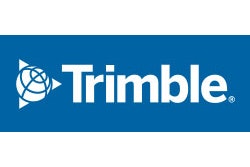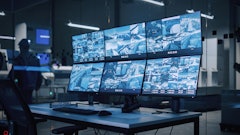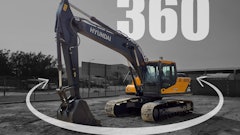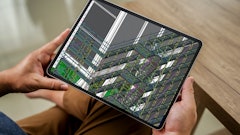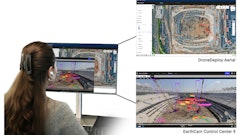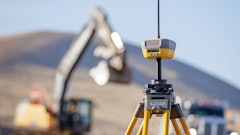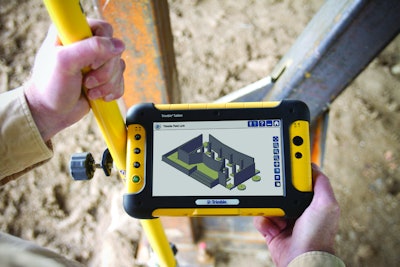
Reduce your workforce and save time, too? Now that’s a win-win for any operation, and one of the reasons concrete contractors turn toward robotic total stations for laying out projects. “I eliminate one person, plus I can locate the points much faster than with a mechanical total station,” says Neal Weiler. The president of Weiler Walls, Inc., in Denver, Pa., purchased a robotic total station in 2006 and hasn’t touched his conventional one since then.
“With a robotic total station, no one needs to be at the instrument,” he explains. “My data collector is clamped to the pole and I just keep walking, and the total station keeps on shooting until I zero in on the point. Not only do I save the labor cost associated with having an individual at the station and the pole, the fact that the system is continually shooting saves time having the prism holder plumb the rod and then the individual at the instrument shooting.”
Weiler installed approximately 200 walls last year, and throughout employed a Trimble 5605 robotic total station equipped with Trimble LM80 Layout Manager software to layout excavations, footings and wall corners. “The device calculates angles and distances to position a point and can also be used to shoot elevations,” says Weiler. “You simply load all the points into the software and work your way around a site.”
The contractor admits he doesn’t take full advantage of the total station and software capabilities, yet it still delivers a healthy ROI. “Change orders can be sent directly to the total station, allowing the operator to quickly adjust the building position — something we don’t find necessary with our projects,” he relates. “I know it also has Direct Reflex (DR) capabilities and can collect and import data into third-party software for analysis, again something for which we also don’t have an application.”
Learning curve
"When Trimble introduced its robotic total station with LM80 software, the perception by contractors was that they would require a sharp learning curve,” relates Jim McCartney, segment manager for Trimble’s building construction division. “It wasn’t true, however, and once the contractor understood how to operate a robotic total station, not only was the labor cost cut in half but the time associated with training rod holders disappeared, as well.”
“I found the robotic total station easy to learn and easy to use,” adds Weiler. “I attended a half-day course sponsored by a Trimble dealer and taught myself from that point on.”
Kirby Justesen, owner of Formco Foundations in Salt Lake City, Utah, also found the learning curve to be short, not only for himself but for employees. “If someone quits or gets sick, I can have a new operator up and running in a day,” he relates.
Justesen works in the custom home market where he notes that building plans seem to be constantly changing. “AutoCAD drawings, with the most recent changes, can be easily downloaded into the instrument to ensure our measurements are accurate,” he explains. "I believe the robotic total stations are also more accurate than mechanical ones.”
LeRoy Sorenson, product marketing manager for Topcon Sokkia agrees. “Instrument optics are more accurate than the human eye. Hence, having the robotic total station direct the placement of the rod versus a human do the directing allows for a higher degree of accuracy.”
Topcon Sokkia manufactures two brands of robotic total stations under the company name. Sorenson notes that both brands operate similarly, the biggest difference being the wireless communication. The Topcon models GPT-9000A series and the GTS -900 A both feature Spread Spectrum radio versus the Sokkia SRX robotic total stations that operate with Bluetooth technology.
“The Topcon GPT-9000A is also noted for its reflectorless capability, up to 2,000 meters, whereas the Sokkia brand features an extremely robust prism tracking and measurement system,” he adds. “The latter allows the Sokkia units to work in especially difficult environments, e.g., where intensive reflections occur from behind the prisms or where there are repetitive interruptions in the line-of-site.” Four models are available with different angle accuracy grades ranging from one to five inches.
Kansas City, Kan.-based Vanum Construction purchased its first robotic total station, a Sokkia unit, two months ago. “Vanum is a general contractor that specializes in pool construction,” explains Carpenter Foreman Tim Bishop. “I’m using the Sokkia right now to layout a pool and I love it, and will never go back to using a manual total station.”
A 12-year veteran with Vanum, Bishop says that a total station is used to lay out an entire pool site, including the pool, utilities and bath house. “Most of the software is similar to what we were using, which kept the learning curve to a minimum,” he adds, noting, however, that the new unit offers the capability to view a project in 3-D.
Bishop goes on to say that the timing was right to purchase a robotic total station. “It was time to upgrade and cutting the cost of laying out a project nearly in half was very attractive, as well.”
In neighboring Missouri, Kansas City general contractor J.E. Dunn has owned robotic units for several years. It recently expanded its fleet with the purchase of three Topcon IS robotic total stations in October to help lay out building footings, foundations and site work for the new 185-acre, $687 million National Nuclear Security Administration project in the city. “Many of our building projects are quite complex,” explains Craft Superintendent of Carpenters Tino Lipari. “The new robotic units allow us to lay out these complex structures more efficiently and with greater accuracy.”
He points out that savings in both time and labor costs are especially dramatic on large projects like the one above. Having one person versus two walking the site has obvious cost savings. And not having an individual at the instrument constantly directing the prism holder to move right or left a few inches saves a huge amount of time. “When using a robotic total station, the prism holder knows where he or she is at, at all time, says Lipari.”
Even with all the benefits associated with using robotic units, he notes that the company still maintains a fleet of manual total stations. “Not everyone is comfortable with the new technology,” Lipari adds. “Technology is changing so fast. In fact, some of our more veteran superintendents have only recently adapted to using a total station versus more conventional layout methods.”
Pole power
Sorenson says that one of the advantages of robotic total stations is their ease of use, and unlike mechanical total stations, everything happens at the pole. “The motorized instrument is the robot, which the contractor controls from the pole,” he explains. “If you’re measuring a point, the robot will follow your moves with the pole. If you’re staking a point, it directs you to the point. The layout software is the same in both brands and is easy to use, as well, since it was designed specifically to be used by contractors. AutoCAD drawings can easily be downloaded and read by the operator who simply indicates the points to be measured.”
Trimble introduced its LM80 Layout Manager software in 2003, as McCartney points out, to make the layout process more user friendly for contractors. “The software transforms blueprints into easily read graphics in terms with which contractors are familiar,” he says.
Tim Carr, president of Custom Concrete Company in Westfield, Ind., explains how it works for his company. “We receive a PDF blueprint from our customer, convert the PDF to a drawing and then download it to our CustomCAD software. After assigning total station numbers to the corners we export the file from CustomCAD to the Trimble LM80. It’s easy.”
It’s also about differentiating himself from the competition. “In today’s economy, contractors need to deliver value to the customer,” he adds. “Yes, we use the robotic total station to locate corners for excavation, footing and walls. But prior to even winning a project, we use it to gather field conditions. This helps us to determine the wall height, depth of the brick ledge and how much granular fill a basement may need. The application helps us more accurately identify customer needs and pin down costs, at the same time.”
Carr says he is a believer in the robotics. “We started our company in 1969 and spent years using conventional systems. Robotics and the attendant technology have substantially reduced our costs, sped up the operation and allowed us to add value to our service offering. The robotic total station is actually helping us sell," he says.
Trimble introduced a robotic solution with the LM80 in 2006. McCartney explains that it increases productivity in a couple of ways. “A magnetic-drive servo on the instrument improves horizontal and vertical tracking allowing it to maintain lock on the prism, even if the individual holding the rod is walking at a fast pace at close range," he explains. "If lock is lost an audible signal will alert the operator immediately, allowing him to quickly reestablish contact, again in the name of productivity.”
He continues, “The robotic total station is also performing functions behind the scenes that would be taking up an operator’s time and potentially introduce error when using a conventional total station. The Trimble robotic instrument, for example, is not only capable of moving the total station horizontally and vertically, but an exclusive feature called Surepoint automatically corrects back to zero if the instrument wanders in the vertical — something the operators would normally do manually.”
McCartney emphasizes that savings can be dramatic when using a robotic versus a conventional total station. “Yes, going to a robotic total station can increase field productivity three to four times, but that’s only part of the payback equation. If one employee (with benefits) costs $40,000 a year, payback would be within eight months. Add in enhanced productivity and payback is realized within three to six months. Over a five-year period, some contractors have saved upwards of $500,000 just by using a robotic total station.”
“The benefits of robotics extend beyond cost saving and productivity gains,” adds Concrete Foundations Association (CFA) Technical Director Jim Baty. “These units are extremely accurate and concrete contractors who use them have better tolerance and quality control. It doesn’t make any difference if you’re a big operator or small, or if you do or don’t have labor issues. The introduction of robotic total stations has been a welcomed addition to the industry.”
Beyond layout
At the World of Concrete this year, Trimble introduced the Trimble Field Link for structures layout solution for concrete, steel, and general contractors. The system is more powerful and has more memory than LM80; operates on several software platforms and features a 7-inch touch screen. “A contractor can actually load a building model and see what he’s doing in 3-D,” McCartney relates. “By touching a black dot on the screen demarcating a layout point the users can easily open up a window to view different attributes about that specific point.
“There’s also an option that can define and photograph a potential issue in the field, make a PDF of the problem, and attach it to a report that can be e-mailed to the architect or building owner," he continues. "The LM80 is still very viable for most work concrete contractors will be doing. Trimble Field Link, however, offers them a more powerful tool for virtual graphics, giving contractors a better understanding of what they’re actually trying to accomplish in the field.”
The technology in the above work stations can triple the price tag on a robotic total station over that of a conventional unit, yet the savings are dramatic in time, money, productivity and accuracy. They work in all conditions, never get sick and don’t require retraining. “There are very few if any occasions where a conventional system would be preferred over a robotic system,” McCartney notes. “A few contractors may think it’s advantageous to have four eyes on a project rather than two, to ensure against mistakes. Yet the technology on the robotic systems is so advanced that it virtually eliminates any application for their conventional predecessors.”




